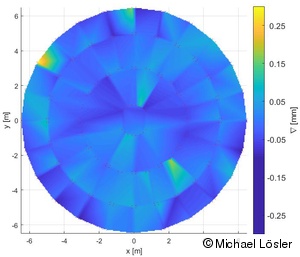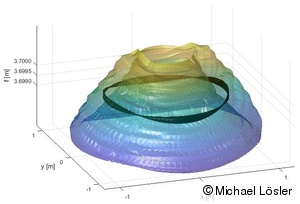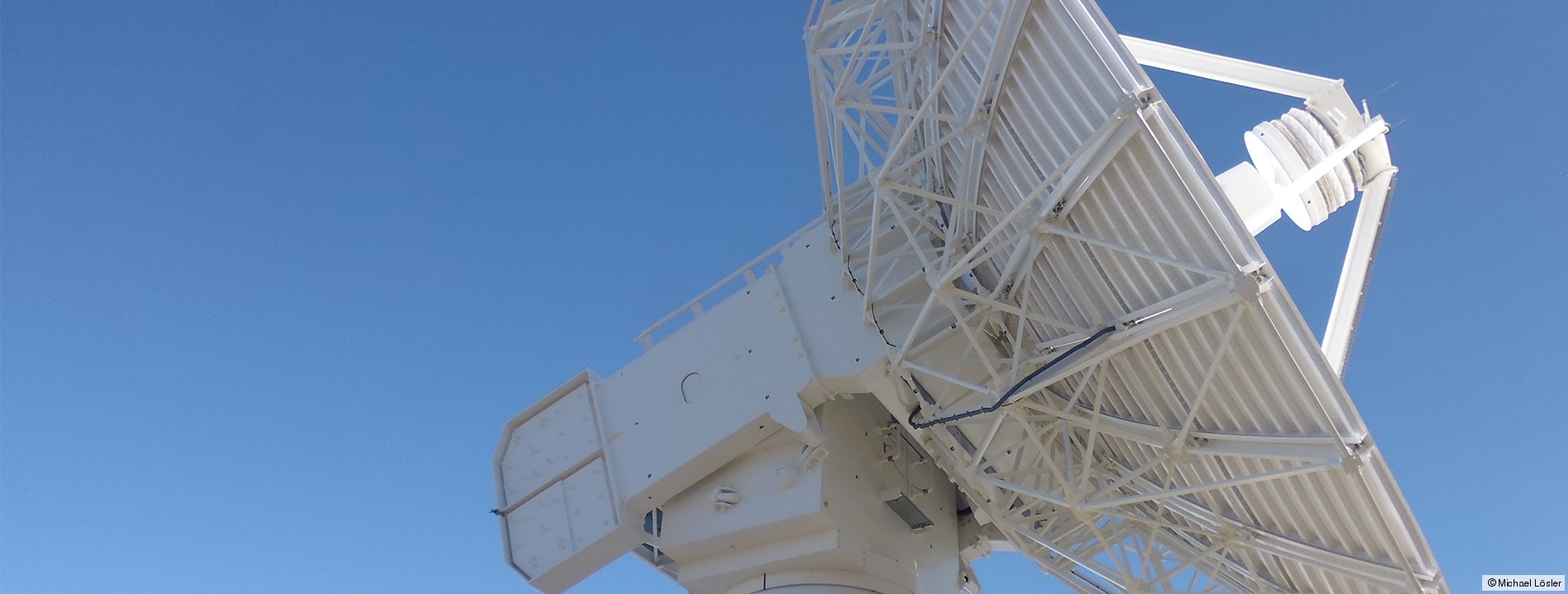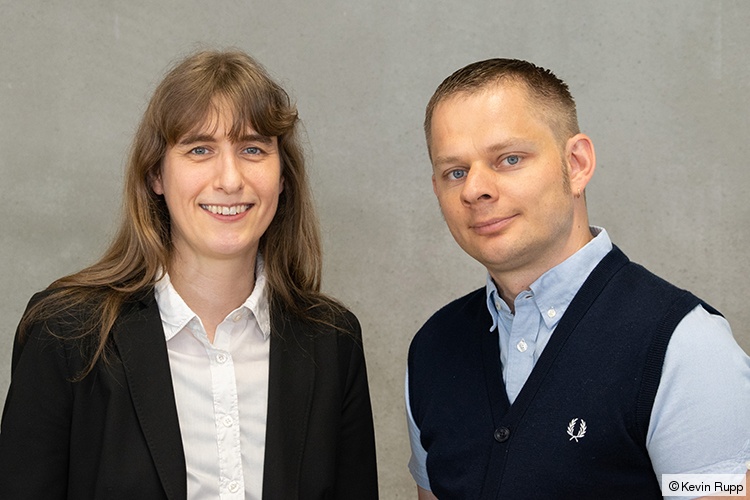VGOS radio telescopes
The International Association of Geodesy (IAG) established the Global Geodetic Observing System (GGOS) in 2003 to provide high quality products for geoscientific issues. The main goal of GGOS is to get a better understanding of global changes and their impact and predictability on Earth. This is fundamental for predicting and for deriving sustainable developments for the future. GGOS derives the geoscientific products - among other - from so-called space geodetic techniques such as Very Long Baseline Interferometry (VLBI). VLBI radio telescopes are facilities equipped with a large parabolic dish as main reflector component. VLBI radio telescopes receives radio waves emitted by quasi-stellar radio source (quasars) in space. Correlating the received signals of several radio telescopes yields the signal propagation delays, which correspond by the speed of light to the baseline lengths between the involved radio telescopes. Tectonic changes, Earth orientation parameters (EOP), or the realization of the International Celestial Reference System (ICRS) are some of the most important global products. The International VLBI Service for Geodesy and Astrometry (IVS) is an IAG service that coordinates the Very Long Baseline Interferometry network.

The receiving properties of VLBI radio telescopes mainly depend on the surface quality of the parabolic main reflector and the stability of the focal length. Temperature, snow loads, wind, insolation, but also dead load deform the main reflector surface. The deformation of the main reflector leads to deviations from the geometry of an ideal, rotationally symmetric paraboloid. Such deformations have been investigated in detail since the 1980s using methods of close-range photogrammetry, holography and laser scanning. The assumed model of a rotationally symmetric paraboloid is justified for most of the so-called legacy radio telescopes. However, radio telescopes that fulfill the increased requirements of the agenda VLBI2010 and GGOS are usually equipped with an improved main reflector design known as Ring-Focus-Paraboloid. Such telescopes are called VGOS radio telescopes and form the backbone of the next generation of the geodetic VLBI system. In contrast to a rotationally symmetric paraboloid, a ring-focus-paraboloid describes a complex geometrical shape and does not belong to the well-known class of surfaces of the second order (quadric).
Reverse engineering: Ring-focus-paraboloid

In order to validate the surface quality of the main reflector of VGOS-specified radio telescopes, the Laboratory for Industrial Metrology has derived an innovative mathematical model to describe the geometry of a ring-focus-paraboloid. This model has been generalized and represents the complex geometry of a double-elliptical ring-focus-paraboloid. An Error-in-Variables (EIV) model formulated by a Sequential Quadratic Programming (SQP) algorithm is used to estimate the shape parameters rigorously. Introducing constraints to the model yields the simplest shape type: a rotationally symmetric paraboloid. For that reason, the model is unified and is suitable to describe the main reflector geometry of many legacy radio telescopes but also to parameterize the improved reflector geometry of most of the VGOS-specified radio telescopes. Hence, the strength of the derived model is the universal applicability in reverse engineering and the framework of main reflector deformation measurements. Moreover, the model of the double-elliptical ring-focus paraboloid is complex and exceeds the designt geometry of radio telescopes. These additional model parameters can be used to interprete obtained surface deviations geometrically.
Quality control and reliability

At the Onsala Space Observatory (Sweden), two radio telescopes, that are identical in construction, have been installed in 2017. Both telescopes are called the Onsala Twin Telescopes (OTT). As for many VGOS-specified radio telescopes, the geometry of the main reflectors is designed as a ring-focus paraboloid. In order to validate the quality and reliability of the main reflectors, the surface was measured by the manufacturer MT Mechatronics (Mainz, Germany). Due to the high accuracy requirements, the measurements were performed by close-range photogrammetry. The uncertainty of an observed spatial position is about 5 µm + 5 µm/m. This remarkably high accuracy is required to detect and to identify deviations of the surface with respect to the designed geometry. The result of the measurements form the basis for readjusting the main reflector surface of the OTT. The RMS of the final adjustments was well below 100 µm and meets the VGOS specifications.
Deformation behavior of VLBI radio telescopes

Due to main reflector rotations around the elevation axis of the VLBI radio telescope, the position of center of mass of the main reflector is shifted and elevation-dependent deformations of the main reflector occur. These deformations change the focal length and - among other - affect the receiving properties of a VLBI radio telescope. Investigations of legacy VLBI radio telescopes show discrepancies on the centimeter level which, if unconsidered, bias the global position and the scale of the reference frame systematically. In order to study the deformation behavior of compact VGOS-specified VLBI radio telescopes, the surface of the main reflector as well as the sub reflector position was photogrammetrically observed in several elevation positions at Onsala. For the first time, the surface measurements are carried out by an unmanned aerial vehicle (UAV). In total, 21 measurement campaigns were performed and the variation of the focal length of one of the Onsala Twin Telescopes was derived. The OTT-design is more compact and stable, and in comparison to legacy radio telescopes the obtained variation of the focal length is about 10 times smaller. For the telescope under investigation, an elevation-dependent correction function was derived to compensate for variation of the signal path. The maximum signal path variation is about 500 µm and yields a time delay of less than 2 ps.
Lösler, M., Kronschnabl, G., Plötz, C., Neidhardt, A., Eschelbach, C.: On the consideration of frequency-dependent illumination functions in modelling signal path variations. In: Haas R., Schroth, E., Neidhardt, A. (Hrsg.): Proceedings of the 26th European VLBI for Geodesy and Astrometry (EVGA) Working Meeting, 11-15 June 2023, Technical University of Munich, Bad Kötzting, Germany, pp. 114-120, 2023. DOI: 10.14459/2023md1730292
Greiwe, A., Brechtken, R., Lösler, M., Eschelbach, C., Kronschnabl, G., Plötz, C., Neidhardt, A.: Close-Range Photogrammetry for Antenna Deformation Measurements. In: Haas R., Schroth, E., Neidhardt, A. (Hrsg.): Proceedings of the 26th European VLBI for Geodesy and Astrometry (EVGA) Working Meeting, 11-15 June 2023, Technical University of Munich, Bad Kötzting, Germany, pp. 70-75, 2023. DOI: 10.14459/2023md1730292
Lösler, M., Kronschnabl, G., Plötz, C., Neidhardt, A., Eschelbach, C.: Frequenzabhängige Modellierung von Signalwegvariationen an VLBI-Radioteleskopen. Zeitschrift für Geodäsie, Geoinformatik und Landmanagement (ZfV), 148(3), pp. 177-187, 2023. DOI: 10.12902/zfv-0429-2023
Lösler, M., Eschelbach, C., Greiwe, A., Brechtken, R., Plötz, C., Kronschnabl, G., Neidhardt, A.: Ray Tracing-Based Delay Model for Compensating Gravitational Deformations of VLBI Radio Telescopes. Journal of Geodetic Science, 12(1), pp. 165-184, 2022. DOI: 10.1515/jogs-2022-0141
Lösler, M., Eschelbach, C., Holst, C.: On the Impact of the Coordinate Representation onto the Estimates in Least-Squares Adjustment. In: Haas, R. (ed.): Proceedings of the 25th European VLBI for Geodesy and Astrometry (EVGA) Working Meeting, 14-18 March 2021, Chalmers University of Technology, Gothenburg, Sweden, pp. 49-55, 2021. ISBN: 78-91-88041-41-8
Greiwe, A., Brechtken, R., Lösler, M., Eschelbach, C., Haas, R.: Erfassung der Hauptreflektordeformation eines Radioteleskops durch UAV-gestützte Nahbereichsphotogrammetrie. In: Kersten, T. P. (ed.): 40. Wissenschaftlich-Technische Jahrestagung der DGPF, Publikationen der Deutschen Gesellschaft für Photogrammetrie, Fernerkundung und Geoinformation e.V., Vol 29, 4-6 March 2020, Stuttgart, Germany, pp. 346-357, 2020.
Eschelbach, C., Lösler, M., Haas, R., Greiwe, A.: Untersuchung von Hauptreflektordeformationen an VGOS-Teleskopen mittels UAS. In: Wunderlich, T. A. (ed.): Ingenieurvermessung 20: Beiträge zum 19. Internationalen Ingenieurvermessungskurs, Munich, 3-6 March 2020, Wichmann, pp. 411-424, 2020, ISBN: 978-3-87907-672-7
Greiwe, A., Brechtken, R., Lösler, M., Eschelbach, C., Haas, R.: Erfassung von Hauptreflektordeformationen an VGOS-Teleskopen mittels UAS. In: Luhmann, T., Schumacher, C. (eds.): Photogrammetrie - Laserscanning - Optische 3D-Messtechnik: Beiträge der 19. Oldenburger 3D-Tage 2020, Wichmann, pp. 159-167, 2020. ISBN: 978-3879076888
Lösler, M., Haas, R., Eschelbach, C., Greiwe, A.: Gravitational Deformation of Ring-Focus Antennas for VGOS - First Investigations at the Onsala Twin Telescopes Project. Journal of Geodesy, 93(10), pp. 2069-2087, 2019, DOI: 10.1007/s00190-019-01302-5
Lösler, M., Eschelbach, C., Haas, R., Greiwe, A.: Measuring Focal-Length Variations of VGOS Telescopes Using Unmanned Aerial Systems. In: Haas, R., García-Espada, S., Lopez Fernández, J. A. (eds.): Proceedings of the 24th European VLBI for Geodesy and Astrometry (EVGA) Working Meeting, 17-19 March 2019, Las Palmas de Gran Canaria, Spain, pp. 17-21, 2019. ISBN: 978-84-416-5634-5
Lösler, M., Eschelbach, C., Haas, R.: Bestimmung von Messunsicherheiten mittels Bootstrapping in der Formanalyse. Zeitschrift für Geodäsie, Geoinformatik und Landmanagement (ZfV), 143(4), pp. 224-232, 2018, DOI: 10.12902/zfv-0214-2018
Lösler, M., Eschelbach, C., Haas, R.: Zur Modellierung eines Ring-Focus-Paraboloids. In: Luhmann, T., Schumacher, C. (eds.): Photogrammetrie - Laserscanning - Optische 3D-Messtechnik: Beiträge der 17. Oldenburger 3D-Tage 2018, Wichmann, pp. 222-234, 2018. ISBN: 978-3-87907-643-7
Prof. Dr.-Ing.
Cornelia Eschelbach
Phone: +49 (0) 69 1533-2356
cornelia.eschelbach(at)fra-uas.de
Dr.-Ing.
Michael Lösler
Phone: +49 (0) 69 1533-2784
michael.loesler(at)fra-uas.de
Address
Transfer centre
Steinbeis Transfer Centre Applied Geodesy
https://applied-geodesy.org
Member of SCGD
Member of the Society for Calibration of Geodetic Devices e.V. (SCGD)


